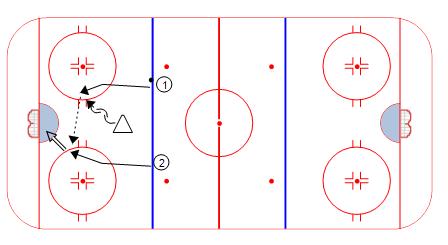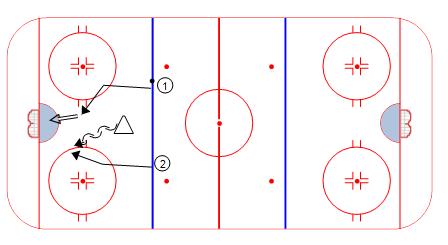2 on 1 Dissected (Part 2)
Back in December, we broke down the offensive side of a 2 on 1 rush in our 2 on 1 Dissected (Part 1) post. In part 2, we will be discussing the strategies and common mistakes made while defending a 2 on 1 rush. The general rule of thumb for defending a 2 on 1 rush is: the goaltender should take the shot and the defender should eliminate the pass across. While this is a good general rule, there are more instances to look into and a couple key additions to be made.
General Responsibilities

The diagram above shows the general responsibilities on a standard 2 on 1 rush. Player 1 is the puck carrier, and the defender wants to prevent shots from the red highlighted area.
Rule Addition #1: Stay between the attackers
First let’s dissect the rule’s intention. By allowing a pass to the weak-side player, the goaltender is forced to move laterally. A quick pass and shot to the back door will often times result in an easy “tap-in” goal where the goalie has no chance of making it across in time. In addition, when goalies are forced to move laterally there are gaps in their coverage – or openings for a shooter to score. Forcing the puck carrier to shoot gives your goalie the opportunity to square up to the puck and play angles properly.

An important point to consider while defending a 2 on 1 rush is the location of your stick, and its role in clogging the passing lane. Defensemen should keep their stick in the passing lane in order to expand the amount of space taken up. The more space a defender covers, the more difficult it will be for a forward to slide a pass through the middle of the ice.
Rule Addition #2: Force the puck to the outside
By defining the areas we don’t want shots to come from, we get a better understanding of the general rule. Often times inexperienced defensemen will make the mistake of drifting over to the weak-side player, giving the puck carrier a better scoring opportunity by cutting to the middle of the ice (into the red in the first diagram). The diagram below shows how this mistake often plays out.

When this mistake occurs, player 1 has an opportunity to shoot the puck in a high-quality scoring area – thus he/she has now become more dangerous than the weak-side player. As the puck carrier gets closer to the middle of the ice, the more dangerous he becomes and the less dangerous the weak-side player becomes. The weak-side player’s threat is deteriorated because as the puck carrier moves to the middle, the goaltender should be tracking with the puck and becoming more centered in the net. The more centered the goaltender is in net, the less distance he will have to move across for a weak-side pass.
When properly executed, as the play gets deeper in the zone, the defending player should provide increased pressure on the puck carrier. This is accomplished by subtly angling closer to the puck carrier while maintaining a good coverage of the passing lane via an active stick. The diagram below illustrates this basic skating pattern.

The above rules work well for standard 2 on 1 rushes with a forward cutting down one side with the puck and another down the weak-side while driving the net. Now, let’s take a look at two non-standard scenarios and discuss how to approach the defense of these rushes.
Criss-Crossing
One of the most confusing plays for inexperienced defenders is the criss-cross play. A natural reaction to the criss-cross would be to take one player, however making that decision will most likely lead to a prime scoring opportunity. The key to remember while handling a criss-cross is to hold the ground in the middle of the ice and attempt to stay between the players. We’ve already explored how committing to one player too early can lead to disaster – hold the ground and force the puck to the outside.

Delays
Another favorite tactic of forwards is to have the puck-carrying player delay and allow the weak-side player to continue driving the net. This often creates confusion for the defender as he struggles to know how to defend the increasing gap between players. The delay is one of the hardest tactics to defend, and requires proper body and stick positioning. The goal still needs to be staying between the players. In order to cover the increased distance between the players, a defender’s stick becomes essential in taking away space for the pass. As the puck carrier gets closer to the net, the gap should decrease. Defenders also need to be sure to not turn their back on the puck carrier.


Just been discussing the vagaries associated with defending the odd man rush. The craftier the puck carrier the more difficult it is to defend. You have addressed this 2 on 1 topic with much adroitness and have very much simplified how to defend against it. You have just made my life more complicated as a coach as I will have to add criss crossing and delaying progressions to my practice plans!
Nicely thought out. It drives me nuts when the defender drops to the weakside thus giving a full on breakaway to F1 forward. Yes, it is nice to let the goalie square up but not if you give a full on 1-0. Thanks